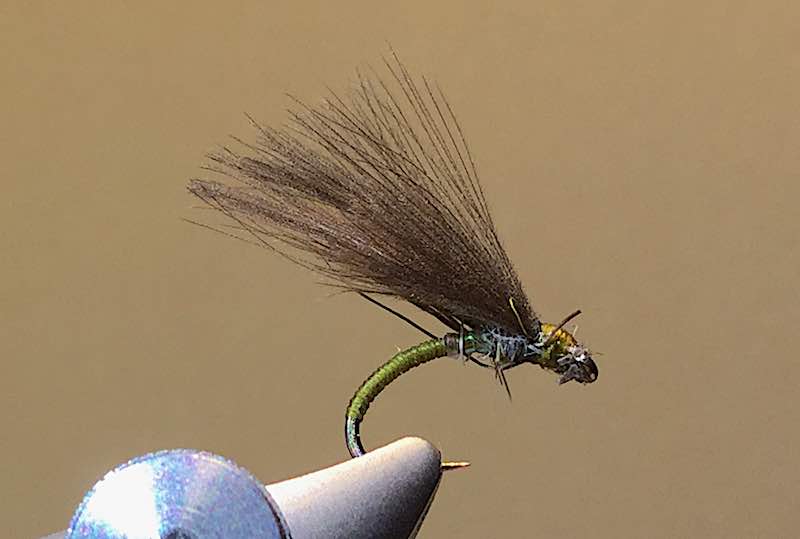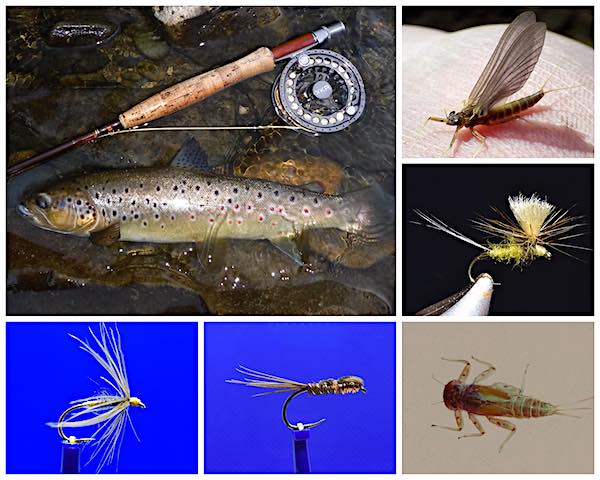The Olive Upright (Rhithrogena Semicolorata) is a very important spring trout fly on many UK rivers. It appears when hatches of March Brown and Grannom flies have ceased, and thus, is a very…
important food source for wild brown trout.
Therefore, when wild brown trout fishing between May and July, it is worth having suitable imitations in your fly box.
This article will briefly cover each stage of the fly’s life cycle, and the nymph, wet flies, and dry flies imitation I use to catch trout.
Habitat & lifecycle of the Olive Upright
Nymph:
It starts life as a stone-clinging nymph and is found in chalk streams and rivers of north and southwest England, Scotland, Wales, and Ireland.
These flattened stone clingers are predominantly found underneath submerged rocks in the riffle sections of rivers and streams.

The nymph has a squat body, dark upward-looking eyes, three tails, and is translucent brown-olive (ca. 10mm long). Its wing case darkens as it matures.
The fly is a close relative of the March Brown, and its life cycle is similar to that of other upwinged flies:
- When it’s ready to hatch, the nymph crawls out from its underwater habitat and swims to the surface.
- At the surface, the nymph emerges from its shuck to transform into a dun.
- Duns pause on the surface while their wings dry and then fly off to find cover and mature into a spinner.
- Once mated, the female spinner crawls down semi-submerged rock and bank-side vegetation to lay her eggs or flies low over the water and dips her abdomen into the surface to release eggs periodically.
- Finally, the spent female spinners drop onto the water and are washed downriver in foam lanes. In the evening, these spent flies are easiest for trout to seize.
It’s only when the nymph leaves the sanctuary of the riverbed to hatch that they are available for trout to feed on.
Fishing nymph patterns:
While waiting for an Olive Upright fly hatch, I start fishing fast riffles and pool heads with a team of wet flies with either a pheasant tail nymph or Hare’s Ear nymph.
I find the best imitation is a pheasant tail nymph, where the body has been tied with a pronounced taper from head to tail. A size 16 hook will produce a nymph of the correct length (ca. 10 mm).

- HENDS BL354 hook sizes 18 or 16
- Fine copper wire as thread
- 4 to 5 pheasant tail fibres
For fishing in fast water, heavy variants with tungsten beads are often needed.
Also, in early spring, it is sometimes more productive to use a bigger nymph (size 14 or 12)
If the PTN doesn’t work, I reached for this Hare’s Ear nymph…

Gold ribbed Hare’s Ear nymph
- Hook: Kamasan B170 #18 to 14
- Weight: 3-4 turns of fine lead wire (optional)
- Thread: Rusty orange 8/0 Uni
- Tail: Badger cock fibres
- Body: WAPSI Hare’s ear
- Rib: Gold tinsel
- Thorax: Hare’s Ear dubbing
- Wing case & legs: 6 pheasant tail fibres
Note – if you are buying nymphs, select ones that have been tied with a thin body profile, ca. 3 mm max.
Usually, when trout start taking the flies on the surface, it is more productive to switch to fishing the…
Olive Upright Dun
The dun is a small fly (ca. 8-10mm long) with a brown-olive coloured body, yellowish rings, and two long tails. The wings are usually clear with a blue-grey tinge to them. Male and female duns are very similar in appearance
Its small size makes it easy to distinguish from the other, much larger, flies that may be hatching (i.e. the LDO and the Large Brook Dun).

Duns hatch from early May until mid-August, peaking in June. In May, on the Welsh Dee, hatches occur from about 11 am and can last for a few hours, with major bursts of activity only lasting around 15 to 30 minutes.
Whereas in the summer months, hatches occur early in the morning and in the evening, the evening hatch is often the heaviest.
Fishing for trout feeding on emerging duns
The best hatches of Olive Upright flies often occur in riffle sections and in the oxygenated runs at the top of pools.
Examples of such pools on the Welsh Dee include:
Studying the aforementioned pools will provide a clear understanding of what pools to look for on other rivers.
Spider fishing / Wet fly fishing
I enjoy spider and wet fly fishing, especially when searching for trout that are not showing themselves by taking dry flies off the surface.
For this roaming approach, I use a three fly cast spaced 3ft apart on a 3lb copolymer leader consisting of #14 Hare’s ear (point), #14 Pearly Butt Waterhen Bloa (middle); #14 pearl ribbed MB spider.
Fishing this team of flies upriver is often deadly during the early stages of a hatch. Especially when trout are feeding on emerging insects and ignoring those sitting on the surface, drying their wings.
When you’re not comfortable fishing a team of wet flies, it’s best to fish a single fly, either the pearly butt Waterhen Blog or a March Brown spider.

- Hook: Kamasan B402 #14 &16
- Thread: Primrose silk
- Tag: Pear Mylar (1/32)
- Body: Finely dubbed Mole fur
- Hackle: Waterhen undercover wing

- Hook: Partridge L3A-S #14
- Thread: Rusty orange UNI 8/0
- Body: WAPSI Fox Squirrel
- Rib: Glod wire
- Hackle: Brown partridge neck
Once trout are seen taking the emerging duns, it’s often best to switch to dry fly fishing.
Dry fly fishing
If you’re a dry fly fishing purist, a hatch of Olive Upright duns can produce some spectacular sport. However, you need to be ready to take advantage of these moments because hatches often occur in…
15 – 30 min sporadic bursts throughout the day.
Take care presenting the dry fly because you don’t want to spook what might turn out to be a trophy brown trout.
Olive Upright dry fly patterns:
If you are limited to shop-bought flies, a Greenwell’s Glory (size 16 to 14) is an acceptable imitation of the dun. On heavily fished rivers, however, a closer imitation will be required when fishing gentle glides.
The following Paradun is my favourite dry fly to match a hatch of Olive Upright duns. I only apply floatant to the para-post so that its body sits in the surface film.

OU Paradun
- Hook: Kamasan B402 #16 & 14
- Thread: Cahill UNI 8/0
- Body: Light Olive SLF dubbing
- Post: Cream Antron yarm
- Thorax: Brown SLF dubbing
- Hackle: Cree cock feather
Sometimes, a more delicate approach is required when trout are ignoring the Para-dun. This is when I reach for a small CDC fly, which is fairly easy to tie.

CDC Olive Emerger
- Hook: Kamasan B100 #16 & 18
- Thread: Olive UNI-Thread 8/0
- Thorax: Hare’s ear dubbing
- Under Wing 4-6 deer hair fibres
- Wing: 3-4 CDC feathers
This fly was designed to have a small footprint and ride low on the surface. It picks out the fussy trout on slow flat glides. Whereas it is difficult to see on broken water, and takes are often missed.
Treat the wing and thorax and CDC oil to keep the fly on the surface. When the fly becomes waterlogged, dry it with an ‘Amadou’ patch, and reapply CDC oil to the wing.
Olive Upright Spinners
In the evening, the mated female spinner flies upstream and descends to the surface of the water to release a few eggs by repeatedly dipping the tip of her abdomen into the water’s surface. Once her egg supply is finished, the spent female falls onto the surface and is easy prey for trout.
The spinner has a light to mid-brown body and translucent wings. The pheasant tail (size 16) is an acceptable imitation of the fallen fly.

Pheasant tail spinner
- Hook: HENDS BL345 #16
- Thread: Olive UNI-Thread 8/0
- Tail: Ginger cock
- Tag: Pearl Mylar
- Body: Pheasant tail fibres
- Rib: Fine gold wire
- Wing: Cream Antron yarn
Finally, I hope you have found this article interesting and that it helps you catch some beautiful trout on your local river. If you want to learn about river flies and when they hatch, you will find the following fly guide useful…
Acknowledgements:
Finally, a kind thanks to Gareth Lewis for providing the photograph of the Olive Upright fly for this article.

Brilliant piece Andrew on the Dee in June with a hatch of olives , how good does that sound ,
Hi James,
That sounds great to me. I will be there fishing on the Dee at least once a week as soon as the lockdown is lifted for the rest of the year and behond! If you give me a shout when you’re going maybe we can meet up.
Cheers, Andrew
James,
That sounds great to me.
Cheers, Andrew
Informative, interesting and well illustrated nice one Andrew
Hi Steve,
Thanks for the feedback – it’s great to hear you enjoyed the post.
Thanks, Andrew
Cheers
hi brilliant piece again very good
Cheers
Hi Andrew, new to your site have been looking for good information on the Dee as its been many years since I have fished it. Your site is perfect thanks for the great info on fly’s and techniques. Look forward to your future posts through out the coming year and maybe seeing you on the river !!
Thanks Tony
Hi Tony,
It great to hear you have found the site interesting and useful. It still a work in progress and there is a lot more to add that I hope will be as interesting.
It would be good to see you on the river. Once the restrictions are lifted I will be back to fishing there every week.
Thanks, Andrew
I am in Eastern North America, across the pond, but the flys will almost certainly work here too! Thanks for the patterns! Tight lines, stay safe!
Hi Mike,
Great to hear you enjoyed the post.
Good luck with the flies. Cheers, Andrew
Wow. Glad I found you. Great stash. Thx for sharing
Rick
Hi Rick,
The site is still a work in progress and there will be a lot more added this year.
Thanks for the feedback, Andrew.
Cheers, Andrew
Fished the Dee just up from Bala some years ago, had one nice Brownie can’t remember what fly I used.
Hi Andrew,
A great selection thanks.
Must do some tying!
Cheers Steve
Thanks
Great article as a beginner to the sport of fly fishing I am trying to absorb as much information as possible our rivers (River Wear)are a little behind you in the hatchlings so look forward to putting this into practice not too sure on fishing with three flies on my line though
Good luck.
good info again andrew thanks
You’re welcome.
Just started to follow the blog Andrew. Great article. Thank you!
Hi David,
Great to hear you have found my blog and you are finding it useful.
Cheers, Andrew
Good article
Cheers
Andrew, this as usual is a very educational article for both beginners and some of the more advanced muscari enthusiasts. In other places you buy this information, and maybe not so clearly. I am grateful to have access to your information. You are a wonderful soul. Thank you!
Hi Foghel,
Great to hear my work is appreciated.
Tight lines, Andrew
Very nice
Glad to hear you enjoyed it.
Smashing patterns
Cheers
Extremely informative Andrew. Thanks for the tips and dressings, will be trying them out soon on the Corwen beats
Hi Scott,
Great to hear you enjoyed it. Also, would be great to know how you get on with the flies.
Tight lines, Andrew